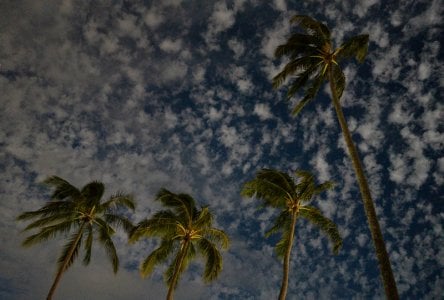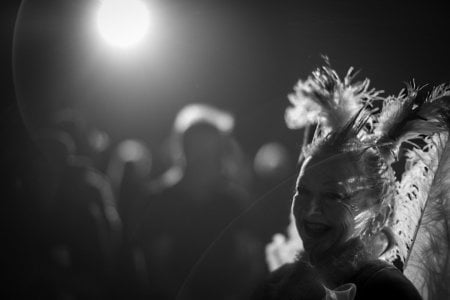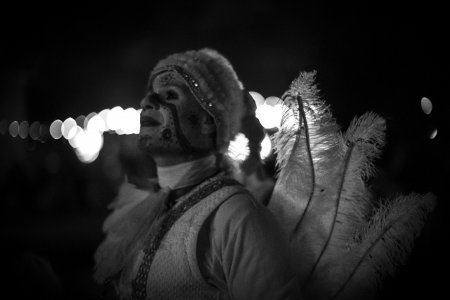Benjamin Marks
Mentor
I took a picture this morning and the camera I was using chose ISO 5000 @f:4 for me for an indoor environmental portrait. The resulting file had a little noise in it -- comparable to Neopan 400 back in the day. Pleasing structure overall, to my eye at least. I had chosen the aperture and let the Nikon do the rest.
The lens was an adapted Zeiss 35/2.8 Biogon -- a beautiful lens in terms of its rendering, if not particularly fast one.
My question is this: given how well today's sensors perform, do you really need an f:1.4 or f:1 lens?
The lens was an adapted Zeiss 35/2.8 Biogon -- a beautiful lens in terms of its rendering, if not particularly fast one.
My question is this: given how well today's sensors perform, do you really need an f:1.4 or f:1 lens?
dexdog
Mentor
I agree with your idea of how well sensors perform. I think that a lot of people like and use fast lenses for the shallow depth of field and rendering of out of focus areas. Not my thing, but I understand why people do it. I was taking a buncha pics a few days ago at a museum, most were shot at ISO 4000. PIcs are great, almost no digital "noise" in processed jpegs
FrozenInTime
Well-known
Film has not gotten any faster, so that use case remains relevant to many.
However even with digital, the dynamic range of the sensor decreases as effective ISO is boosted so, images taken at ISO 400 should have better tonal range than ones at 5000 ... 50000.
For practical purposes though, ISO 5000 on a modern digital camera may be more than good enough; and a slower lens should be more compact and have fewer aberrations than a super speed lens.
However even with digital, the dynamic range of the sensor decreases as effective ISO is boosted so, images taken at ISO 400 should have better tonal range than ones at 5000 ... 50000.
For practical purposes though, ISO 5000 on a modern digital camera may be more than good enough; and a slower lens should be more compact and have fewer aberrations than a super speed lens.
Cascadilla
Well-known
You make a good point, especially when so many images will never be printed at all, let alone at a large size where noise would become obvious. For film users and those who need shallow DOF for the kind of images that they want to make there is no substitute for fast lenses, although there is already software built into cell phones to simulate shallow DOF. Since I don't own a phone like that I don't know how successful it is at emulating an actual fast lens.
Godfrey
somewhat colored
- Fast lenses allow more focusing zone control as well as the ability to capture in low light with short exposure times. Fast lenses are also bulkier, heavier, and pricer than slower lenses, and may not be as well corrected or perform as well as slower lenses.
- Sensitive, high resolution sensors with low noise characteristics and high dynamic range allow for more flexibility in setting exposure, and can obviate the need for fast lenses in average circumstances.
In other words, if you normally stop down your lenses to the middle range of their aperture capabilities for aesthetic or other reasons, or tend to want to shoot in very low light, a high sensitivity sensor lets you capture exposures using shorter exposure times and allows using slower lenses at the limits. Whether you need the fastest lenses for more flexible aperture control or for making photos in "available darkness", well, that gates what sorts of lenses you should be interested in given a high sensitivity sensor.
G
Oh yes: Remember that what is considered a "fast" lens has changed a lot over the years. When I started in Photography, a lens faster than f/4 was considered "fast" ... many of my lenses over the years have been f/2.8 maximum aperture and I always considered them to be quite fast. Nowadays, f/2.8 is considered "slow" and "fast" is reserved for f/1.4, f/1.2, f/1, and f/0.95 ... which, in the days when I started, were considered to be "ultra fast, hyper expensive lens exotica" that no one at my pay grade ever had.
- Sensitive, high resolution sensors with low noise characteristics and high dynamic range allow for more flexibility in setting exposure, and can obviate the need for fast lenses in average circumstances.
In other words, if you normally stop down your lenses to the middle range of their aperture capabilities for aesthetic or other reasons, or tend to want to shoot in very low light, a high sensitivity sensor lets you capture exposures using shorter exposure times and allows using slower lenses at the limits. Whether you need the fastest lenses for more flexible aperture control or for making photos in "available darkness", well, that gates what sorts of lenses you should be interested in given a high sensitivity sensor.
G
Oh yes: Remember that what is considered a "fast" lens has changed a lot over the years. When I started in Photography, a lens faster than f/4 was considered "fast" ... many of my lenses over the years have been f/2.8 maximum aperture and I always considered them to be quite fast. Nowadays, f/2.8 is considered "slow" and "fast" is reserved for f/1.4, f/1.2, f/1, and f/0.95 ... which, in the days when I started, were considered to be "ultra fast, hyper expensive lens exotica" that no one at my pay grade ever had.
A
AndyCapp
Guest
Some people need fast lenses in some situations.
I do not need them but I like to isolate the subject with the narrow depth of field.
They have a certain status value also.
I do not need them but I like to isolate the subject with the narrow depth of field.
They have a certain status value also.
SWB
Member
Never been a fan of billing a cooing over 'creamy bokeh', fast lenses used to be for low light and that's how I've used them. Nevertheless I've got fast Nikon and Leica lenses for film use but rarely open them up nowadays because of the photography I now do. But it has been the case that the best lenses were the usually the faster ones in any camera range, and I kept with that idea until I got my Nikon Z7 along with the 'kit' 24-70 f/4. It is such a good lens as a standard zoom that my lusting over a faster f/2.8 has disappeared, not least because of the extra size and weight involved. So yes, if you don't need a fast lenses they aren't needed anymore, even for low light photography.
Dogman
Mentor
Bokeh. The holy grail of 21st Century photography. If you ain't got it, you ain't jackschnitz. ƒ/0.0001 lenses are hot!
Despite better quality lenses and a presentation system that is more versatile, I cannot truly say we are achieving better photographs than those done by the likes of Walker Evans, Cartier-Bresson, Willy Ronis, Gene Smith, Robert Frank, etc.
Despite better quality lenses and a presentation system that is more versatile, I cannot truly say we are achieving better photographs than those done by the likes of Walker Evans, Cartier-Bresson, Willy Ronis, Gene Smith, Robert Frank, etc.
Godfrey
somewhat colored
The popular use of the term bokeh these days is really messed up.
Bokeh does not mean "the blurry mush of imaged items out of the focus zone at a large aperture". Bokeh is "the quality of the blur in the blurred portions of an image"... Bokeh is something you can evaluate at any aperture, in any scene, by looking at blurred portions of an image and evaluating whether they have a pleasing or harsh appearance.
Yeah, I'm shouting into the gale again...
G
Bokeh does not mean "the blurry mush of imaged items out of the focus zone at a large aperture". Bokeh is "the quality of the blur in the blurred portions of an image"... Bokeh is something you can evaluate at any aperture, in any scene, by looking at blurred portions of an image and evaluating whether they have a pleasing or harsh appearance.
Yeah, I'm shouting into the gale again...
G
JeffS7444
Well-known
"Need"? For most of what I do, not really. But on rare occasions, it can be useful for capturing full color images in low light situations, where human eyes perceive less detail and mostly monochromatic at that. Being able to render nighttime scenes as sort of twilight is pretty new to me.

Shot at f/1.4 @ 1/15th sec and ISO 12800.

Shot at f/1.4 @ 1/15th sec and ISO 12800.
To answer your question: no.

However many shooters want ultra-fast.
For smaller sensor cameras, a faster lens will give shallower DOF which a lot of people want...for some reason or another.
My new-to-me Z6 is a 6 year old sensor design, most of my lenses are f/2.8 or 4. This saves significant size, weight, and cost!
The high ISO performance is impressive, and I'm sure that newer models are even moreso. This saves significant size, weight, and cost!
However many shooters want ultra-fast.
For smaller sensor cameras, a faster lens will give shallower DOF which a lot of people want...for some reason or another.
My new-to-me Z6 is a 6 year old sensor design, most of my lenses are f/2.8 or 4. This saves significant size, weight, and cost!
The high ISO performance is impressive, and I'm sure that newer models are even moreso. This saves significant size, weight, and cost!
Evergreen States
Pierre Saget (they/them)
This is pretty much my view. I welcome innovation in sensor technology, image stabilization and lens design. Most photographers do not need anything faster than ƒ/1.4. Many can do more than well enough with ƒ/2 or ƒ/2.8. Fast lenses were originally a way to provide photographers more shooting opportunities when film speeds were much slower than what we have today. The first Kodachrome had a blistering ISO of 10. Sensor technology has gotten good enough so that fast lenses are not necessary for most of the lighting conditions a person will find themself in. The halcyon years of Kodachrome were captured at ISO 64. Now sensor manufacturers are touting the ability to go down to ISO 64 as innovation in order to maximize dynamic range. The conditions which generated the need for super speed lenses have long since passed. Not to mention that, at many useful portrait distances, shooting at ƒ/1.4 won't get you enough of a person's face in focus for a typical portrait. Shooting spontaneous action wide open can be difficult if you care about getting things in focus, so that limits their utility for street photography.To answer your question: no.
However many shooters want ultra-fast.
However, new advancements in autofocus technology which automatically track objects can make it easier to nail focus on moving subjects at wide apertures. Old super speed lens designs performed poorly wide open and were only there for emergency uses when the softness was an acceptable compromise for getting the picture at all. Now many new lenses are far sharper wide open than those older lenses were stopped down. Many photographers who have more money than talent will shoot boring, repetitive pictures of background blur but you also have creative photographers who gain access to the same tools and make breathtaking work. While we've seen a real decline in varieties of film and darkroom papers available and seen some of the finer film equipment slip back out of the realm of affordability, digital imaging technology offers us an embarrassment of riches. It's up to us to pick up the tools and bend them to our visions, or to use their unique properties to see the world in unique ways.
So while most photographers do not need anything faster than ƒ/1.4, I'm still grateful that faster lenses than that exist. As Frederich Hayek said, "The freedom that will be used by only one man in a million may be more important to society and more beneficial to the majority than any freedom that we all use."
A
AndyCapp
Guest
I avoided using the word 'bokeh' in my posting on purpose.Never been a fan of billing a cooing over 'creamy bokeh', fast lenses used to be for low light and that's how I've used them.
Ororaro
Well-known
Obvious answer is NO.
But nothing much is necessary in life. And owning a Noctilux is so cool, why resist?
But nothing much is necessary in life. And owning a Noctilux is so cool, why resist?
chuckroast
Established
I took a picture this morning and the camera I was using chose ISO 5000 @f:4 for me for an indoor environmental portrait. The resulting file had a little noise in it -- comparable to Neopan 400 back in the day. Pleasing structure overall, to my eye at least. I had chosen the aperture and let the Nikon do the rest.
The lens was an adapted Zeiss 35/2.8 Biogon -- a beautiful lens in terms of its rendering, if not particularly fast one.
My question is this: given how well today's sensors perform, do you really need an f:1.4 or f:1 lens?
Yes, for shooting film - i.e., for those of us that are Real Photographers (tm) .... bwhahahahaaaa
(I kid, I kid. Shoot with whatever bakes your cookies.)
On a more serious note ...
There's more to fast lenses than just low light/low ASA exposure. Fast lenses shot wide open have a distinct character to them that is often desirable. This can include some falloff on the edges of the frame, reduced depth of field, out of focus "bokeh" behavior, and so forth. These can be powerful creative components when properly mastered.
I have both a Nikon 35mm f/1.4 Ai-S and a Leica Summicron 35mm f/2 ASPH for my Nikon and Leica bodies respectively. Both are superb lenses, but very different in how they render a scene at max aperture.
Last edited:
SWB
Member
I avoided using the word 'bokeh' in my posting on purpose.
Sorry, I didn't even realise you'd think I was replying to you.
johnsonjj22
Analog Enlightenment
For film, yes. For subject separation, yes. I shoot professionally and sometimes "fast" glass is the only tool I have left in the bag when nothing about the scene is going to help me make an interesting photo. Fast glass is great, though I do feel is heavily overused these days and is more about being a "crutch" for a lot of photographers still learning how to deal with complicated scenes and compositions.
Salgado apparently rarely shot at widest aperture, saying something to the effect of "it's not how the human eye sees"
Salgado apparently rarely shot at widest aperture, saying something to the effect of "it's not how the human eye sees"
shawn
Mentor
Yes,
Need fast shutter speeds in lower light ( indoor sports) fast glass gives better results then massively cranking iso with slower glass.
Want more subject isolation or to mimic the look of medium format, high iso doesn’t give you that.
Need fast shutter speeds in lower light ( indoor sports) fast glass gives better results then massively cranking iso with slower glass.
Want more subject isolation or to mimic the look of medium format, high iso doesn’t give you that.
Freakscene
Obscure member
wlewisiii
Just another hotel clerk
Photography has never been about how the human eye sees. The B&W images I shot today have nothing in common with how my red-green color deficiency (not too much but enough to be washed out of military aviation) vision sees the world and that has little in common with how someone with perfect red-green color vision sees things.Salgado apparently rarely shot at widest aperture, saying something to the effect of "it's not how the human eye sees"
Every photo is a rendering not a reality.
Share:
-
This site uses cookies to help personalise content, tailor your experience and to keep you logged in if you register.
By continuing to use this site, you are consenting to our use of cookies.



